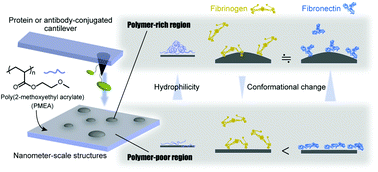Nanoscopic analyses of cell-adhesive protein adsorption on poly(2-methoxyethyl acrylate) surfaces†
Abstract
Regulation of protein adsorption on the surface of biomaterials is important for modulating cell adhesion. Two important proteins in this regard are fibrinogen and fibronectin. Poly(2-methoxyethyl acrylate) (PMEA) and its derivatives have been developed as promising coating materials for biomaterial surfaces. Previous studies have highlighted that PMEA-coated substrates suppress thrombogenicity but promote cell adhesiveness. However, it was unclear what was responsible for these differences in adhesion. In this study, we focused on the correlation between protein adsorption and the nanometer-scale structures on the surfaces of the PMEA substrates. An atomic force microscope using protein- or antibody-conjugated cantilevers was used to perform nanoscopic analyses of the adsorption forces and conformational changes in fibrinogen and fibronectin adsorbed on the nanometer-scale PMEA structures. The adsorption force of fibronectin in the polymer-poor region was higher than that of fibrinogen, whereas the polymer-rich region showed a negligible difference in adsorption force between the two proteins. Interestingly, a greater conformational change in the adsorbed fibronectin was induced in the polymer-poor region than that in fibronectin in the polymer-rich region or fibrinogen in either regions, resulting in the induction of cell adhesion. Nanoscopic analyses of protein adsorption on biomaterial surfaces provide promising insights into the design of novel biomaterials that control protein adsorption and cell adhesion.



 Please wait while we load your content...
Please wait while we load your content...